
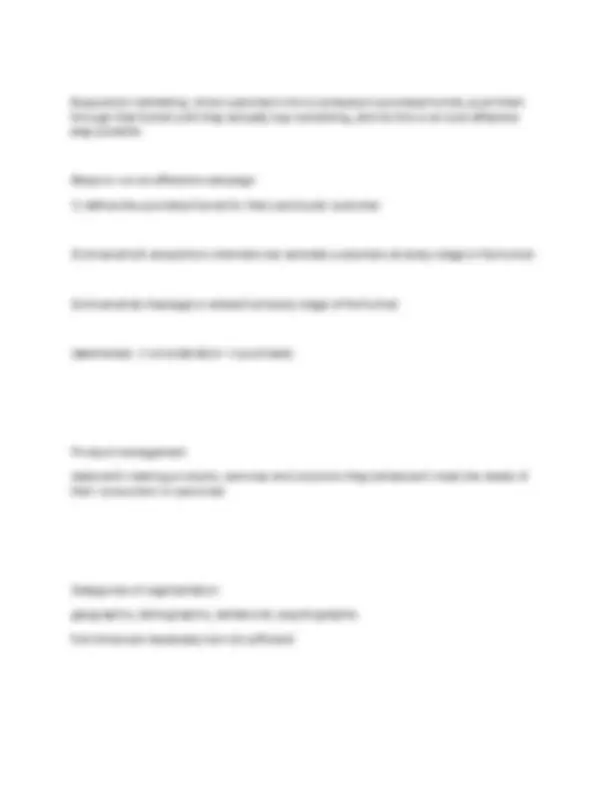
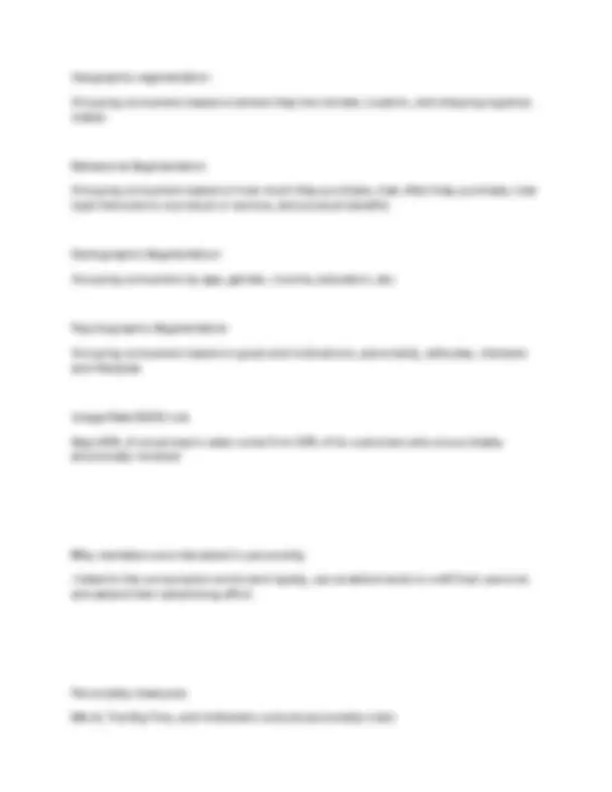
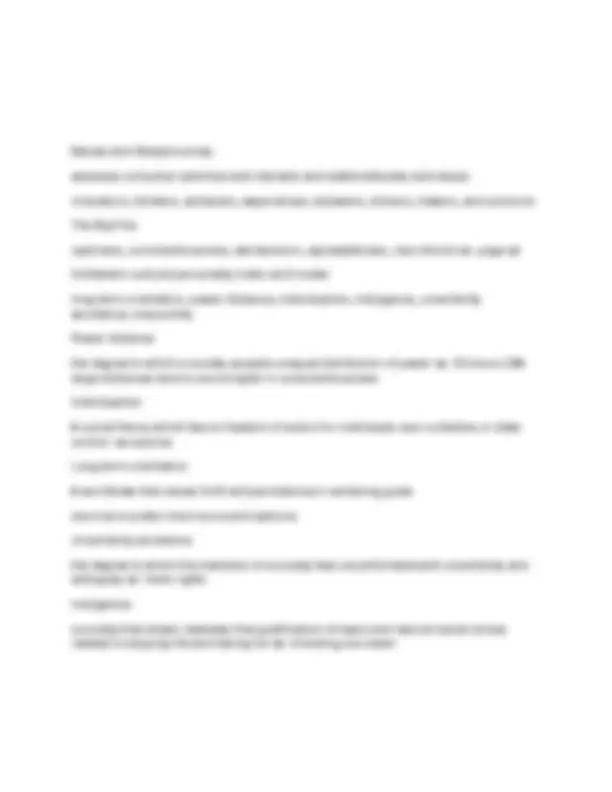
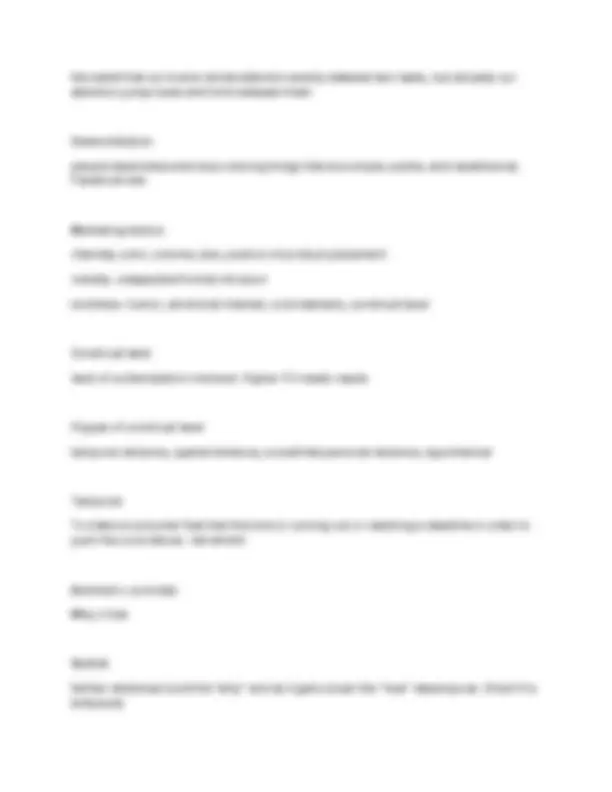
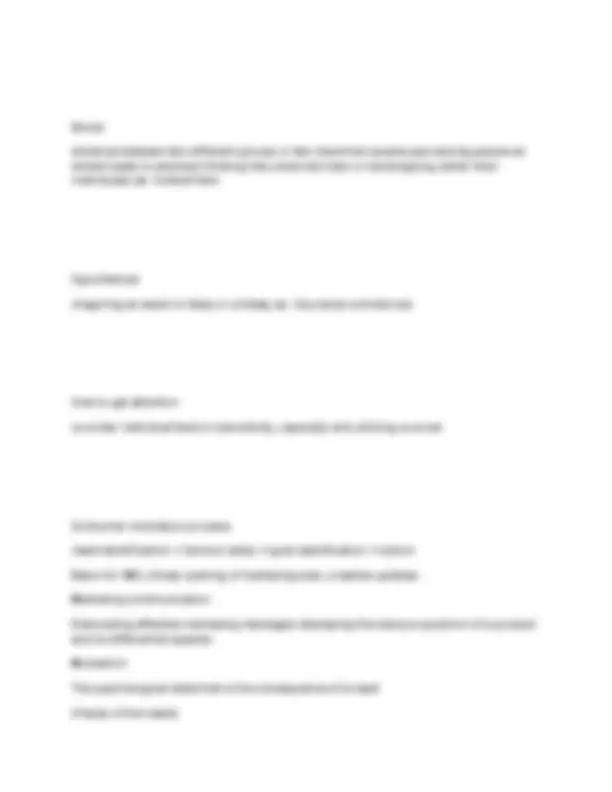
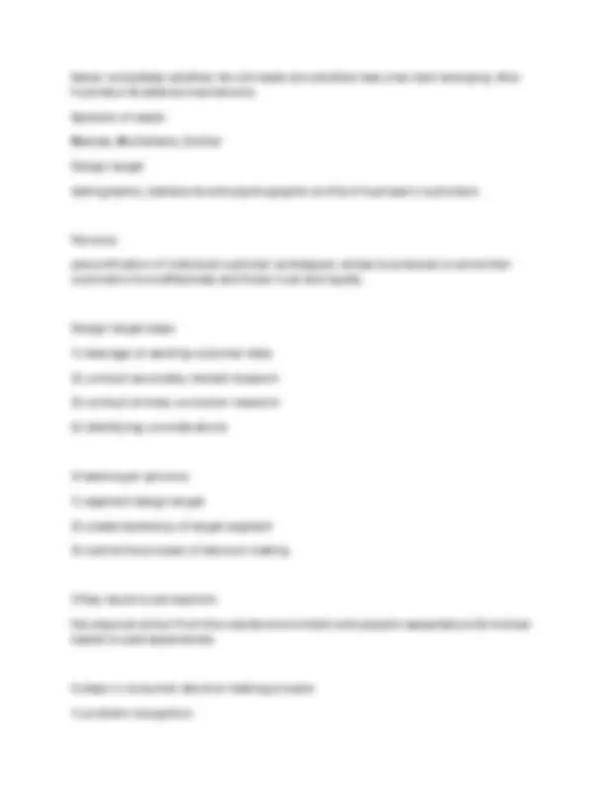
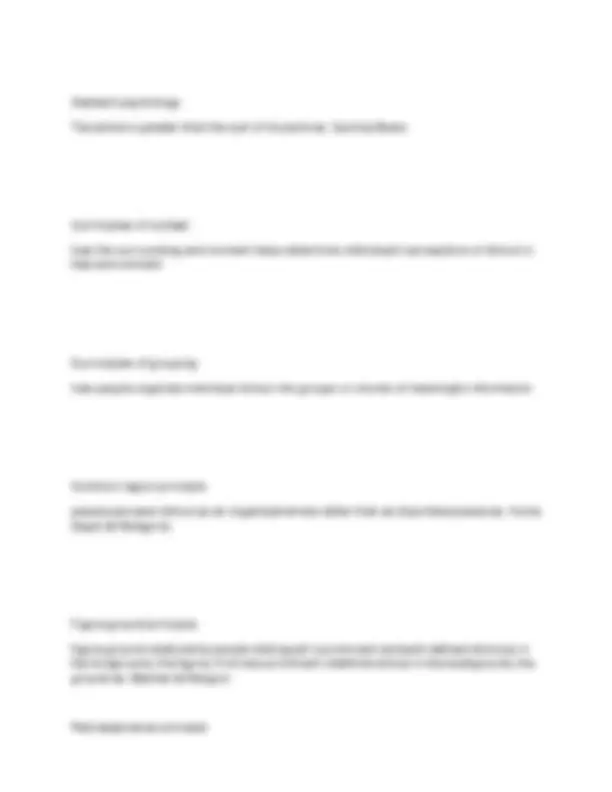
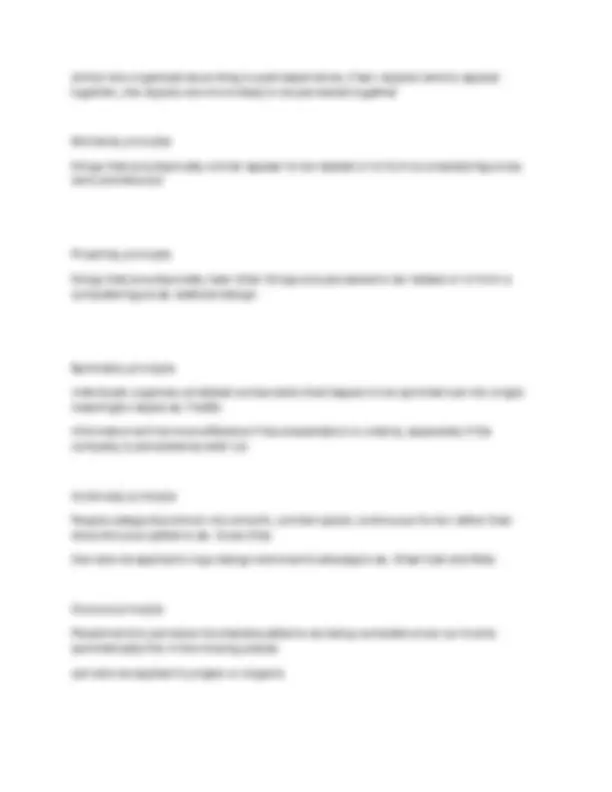


Study with the several resources on Docsity

Earn points by helping other students or get them with a premium plan


Prepare for your exams
Study with the several resources on Docsity

Earn points to download
Earn points by helping other students or get them with a premium plan
Community
Ask the community for help and clear up your study doubts
Discover the best universities in your country according to Docsity users
Free resources
Download our free guides on studying techniques, anxiety management strategies, and thesis advice from Docsity tutors
A concise overview of key concepts in marketing, particularly focusing on segmentation, targeting, and product positioning. It covers various segmentation categories such as geographic, demographic, behavioral, and psychographic, along with related concepts like the majority fallacy, red and blue ocean strategies, and the importance of understanding consumer behavior. The document also touches on consumer motivation, perception, and decision-making processes, offering a foundational understanding of marketing principles. It is useful for students and professionals seeking a quick review of marketing fundamentals, including brand marketing, acquisition marketing, and product management. The document also explores personality measures like vals and hofstede's cultural dimensions, providing insights into consumer psychology and its impact on marketing strategies.
Typology: Exams
1 / 14

This page cannot be seen from the preview
Don't miss anything!









Segmentation dividing a market into subsets of consumers who have common needs
Majority Fallacy false belief that targeting the most amount of people brings the most amount of money
Red Ocean populated market segments with lots of competition ex. yellowtail
Blue Ocean new market space where demand is being created and not fought over
Targeting choosing the segment that is most attractive to your organization
Product Positioning communicating value to one's target market by relating the consumers need/want with what product offers and offering the benefits to satisfy those needs/wants above and beyond competition
Frame of reference (FOR) important to positioning statement because helps product stand out/unique and allows to have the least ammount of competiton you can have. ex. Gatorade flavored water vs sports drink
Reason to believe proof mentioned within the positioning statement that creates brand credibility and authenticity
Consumer behaviour the study of people, groups, or organizations and the processes they use to select, secure, use, and dispose of products, services, experiences, or ideas to satisfy needs and the effects that these processes have on the consumer and society
4 key tenets
Geographic segmentation Grouping consumers based on where they live climate, location, and shipping logistics matter
Behavioral Segmentation Grouping consumers based on how much they purchase, how often they purchase, how loyal there are to a product or service, and product benefits
Demographic Segmentation Grouping consumers by age, gender, income, education, etc.
Psychographic Segmentation Grouping consumers based on goals and motivations, personality, attitudes, interests and lifestyles
Usage Rate 80/20 rule Says 80% of a business's sales come from 20% of its customers who are probably emotionally involved
Why marketers are interested in personality -linked to the consumption and brand loyalty, can enable brands to craft their persona and extend their advertising effort
Personality measures VALS, The Big Five, and Hofstede's cultural personality traits
Values and lifestyle survey assesses consumer activities and interests and stable attitudes and values innovators, thinkers, achievers, experiences, believers, strivers, makers, and survivors The Big Five openness, conscientiousness, extraversion, agreeableness, neuroticism ex. yoga ad Hofstede's cultural personality traits six D model long-term orientation, power distance, individualism, indulgence, uncertainty avoidance, masculinity Power distance the degree to which a society accepts unequal distribution of power ex. China vs USA large distances tend to score higher in conscientiousness Individualism A social theory which favors freedom of action for individuals over collective or state control. ex vaccine Long-term orientation A worldview that values thrift and persistence in achieving goals. short-term prefer time honoured traditions Uncertainty avoidance the degree to which the members of a society feel uncomfortable with uncertainty and ambiguity ex. trans rights Indulgence a society that allows relatively free gratification of basic and natural human drives related to enjoying life and having fun ex. branding ice cream
Inner-directed People guided by their own values and standards - making their own decisions regarding proper behaviour and conduct
Other-directed People who rely on others around them for guidance or advice regarding actions to be performed
Brand personification occurs when consumers apply human characteristics to a brand helps distinguish brand and tends to generate an emotional connection drives higher purchase intentions as well as brand loyalty ex. M&Ms
Conversion Model Motives -> attention -> perception -> categorization & comprehension -> learning -> memory -> attitudes & personality -> persuasion -> decision making
Sense of self a person's thoughts and feelings about themselves and how they live, guided by the ideal self, actual self and extended self
Attention the process whereby we commit mental activity to something (limited, selective, divided)
Multitasking myth
the belief that our brains divide attention evenly between two tasks, but actually our attention jumps back and forth between them
Desensitization people desensitize and stop noticing things that are simple, subtle, and repetitive ex. Facebook ads
Marketing tactics intensity-color, volume, size, position of product placement novelty- unexpected format intrusion vividness- humor, emotional interest, concreteness, construal level
Construal level level of contemplation involved. Higher if it meets needs
4 types of construal level temporal distance, spatial distance, social/interpersonal distance, hypothetical
Temporal To make a consumer feel that the time is running out or reaching a deadline in order to push the concrete ex. retirement
Abstract v concrete Why v how
Spatial farther distances build the "why" and as it gets closer the "how" develops ex. Chick fil a billboards
Never completely satisfied. As old needs are satisfied new ones start emerging. Also frustration & defence mechanisms Systems of needs Maslow, McClelland, Dichter Design target demographic, behavioral and psychographic profile of business's customers
Persona personification of individual customer archetypes- allows businesses to serve their customers more effectively and foster trust and loyalty
Design target steps
Create buyer persona
2 Key inputs to perceptions the physical stimuli from the outside environment and people's expectations & motives based on past experiences
5 steps in consumer decision making process
Ambush marketing the practice of placing ads in places where consumers don't expect to see them or where they simply can't avoid them
Experiential marketing allows customers to engage and interact with brands, products and services in sensory ways in order to create emotional bonds between consumers and companies ex. Refinery 29
Minimum viable product (MVP) a new product launched to the market with only the features necessary to satisfy early adopters
Regulatory focus theory (RFT) a goal pursuit theory regarding people's' perceptions in the decision making process Looks at the relationship between a consumer's motivation and how they are going to attain the goals
Promotion orientation consumers who view their goals as opportunities for gains or advancements. Consumers are less concerned with risks. Respond best to optimism and praise
Prevention orientation consumers who view their goals as opportunities to meet their responsibilities and to stay safe. Consumers want to feel secure. Driven by criticism and possibility of failure
Gestault psychology The whole is greater than the sum of its parts ex. Gummy Bears
3 principles of context how the surrounding environment helps determine individuals' perceptions of stimuli in that environment
5 principles of grouping how people organize individual stimuli into groups or chunks of meaningful information
Common region principle people perceive stimuli as an organized whole rather than as disjointed pieces ex. Home Depot & Pellegrino
Figure ground principle figure-ground relationship people distinguish a prominent and well-defined stimulus in the foreground, the figure, from less prominent indefinite stimuli in the background, the ground ex. Batman & Penguin
Past experience principle
stimuli are organized according to past experience, if two objects tend to appear together, the objects are more likely to be perceived together
Similarity principle things that are physically similar appear to be related or to form a complete figure ex. Iams and Absolut
Proximity principle things that are physically near other things are perceived to be related or to form a complete figure ex. website design
Symmetry principle individuals organize unrelated components that happen to be symmetrical into single meaningful object ex. FedEx Information will be more effective if the presentation is orderly, especially if the company is perceived as well run
Continuity principle People categorize stimuli into smooth, uninterrupted, continuous forms rather than discontinuous patterns ex. Coca-Cola Can also be applied to logo design and brand campaigns ex. Chevrolet and Nike
Closure principle People tend to perceive incomplete patterns as being complete since our brains automatically fills in the missing pieces can also be applied to jingles or slogans.